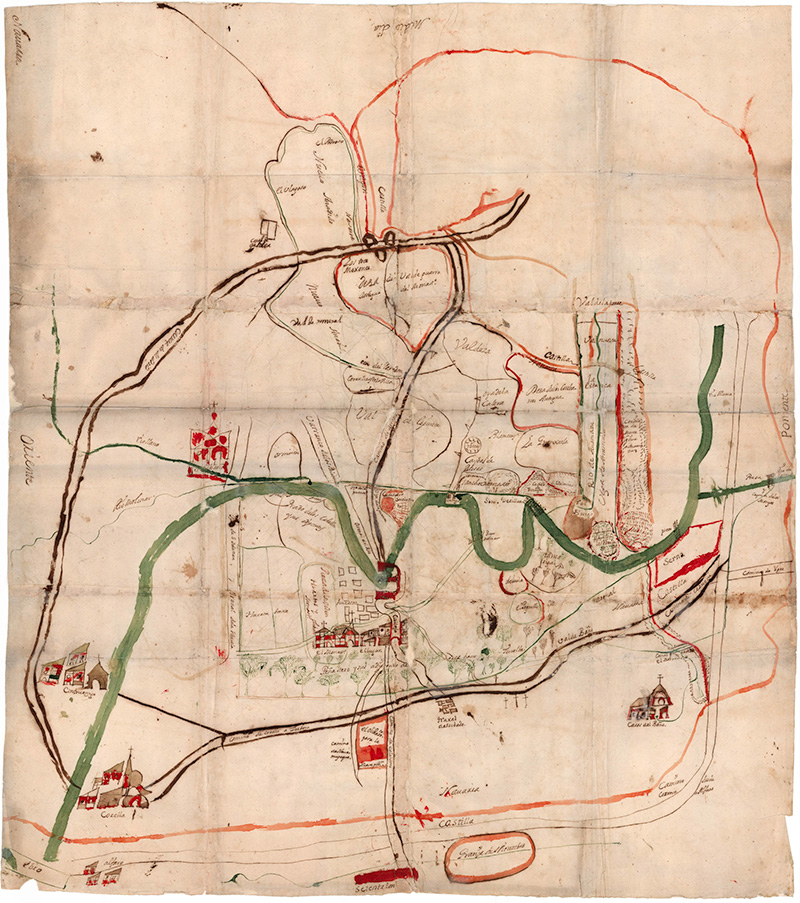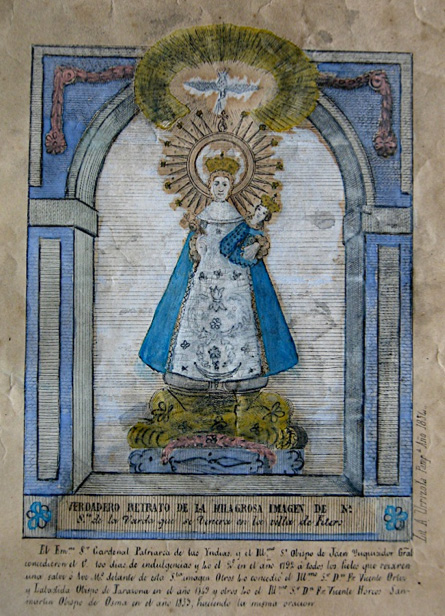400 years ago. A exchange of Marian images between Cervera del Río Alhama and the monastery of Fitero in 1622.

In the year 1622 an extraordinary event took place in the history of the cult of Our Lady of the Barda in the monastery and town of Fitero, nothing less than the transfer of her image for nine days to the Riojan town of Cervera del Río Alhama, while the Virgin of the Mount arrived in the Navarrese town. A notarial deed, notarized by the notary of Fitero Miguel de Urquizu y Uterga, gives us details and particulars of everything that happened in those celebrations.
That singular event should be contextualized in the period of the Counter-Reformation, which brought with it a clear incentive in everything related to Marian worship, both in general dedications such as the Immaculate Conception, the Rosary or Carmen, as well as in the particular dedications of towns and cities, which entered into a real competition, with the construction of new factories for their local dedications, as well as the endowment of their chapels. The legends of her prodigious apparitions, in times when the marvelousness prevailed, the devotional pictures, the joys, the processions and the fairs and festivals in her honor made of many sanctuaries places of pilgrimage and, of course, of pilgrimages, some of which have survived to the present day.
In the monastery of Fitero, the chapel of the Virgen de la Barda had just been endowed with paintings, a new altarpiece, and at the same time the image was being enriched with outstanding jewels, especially silver crowns. Likewise, the fact that her chapel was to become a parish chapel for the town of Fitero, made her cult and affection among its inhabitants grow and her intercession was requested in times of plagues, wars and droughts. That process culminated in 1785, with the vote of the town council for the celebration of her feast on the day of the Sweet Name of Mary and her consideration as patron saint of Fitero.

Plan of Fitero and its surroundings (c. 1600), where the term of La Serna is located, where the exchange of the images took place. file Royal and General of Navarre
The whole manuscript text of 1622, to which we are going to refer, reflects fully baroque customs. In spite of being a notarial certificate , it belongs to the literary genre of the Relaciones and its text is written in a laudatory tone, with enough detail, tendency to exaggeration and purpose to revive, with its reading, those festive conference . Its careful examination and analysis reminds us of the elements involved in the baroque festivities, all of them aimed at the exaltation of the gaudium, with the union of music, the ephemeral, the parades and processions, the sounds and lights that amazed and moved the senses.
The initiative of exchange came from the residents of Cervera, who delegated the request to one of the ecclesiastics of that town in La Rioja, the beneficiary Jerónimo Jiménez. The reason was none other than a persistent drought. The aforementioned member of the clergy met with the prior of the monastery, Friar Martín Jimeno, proposing to bring the two towns together with the Marian images in the area of the Serna meadow and exchange them during a novena. The notary of Fitero, Miguel de Urquizu y Uterga, from Roncal, affirms that "everyone accepted his embassy with great joy for the conformity and union that could follow from such holy processions and exchange". In order to correspond with the protocol, the monastery sent from the monastery its fabriquero, Friar Dionisio de la Iglesia. In the interview of the latter with those of Cervera, it was determined to carry out the ceremony of exchange on May 8 of that year of 1622, at that time a Sunday.
When the appointed day arrived, the procession left Fitero preceded by the raised cross, the prior and the Cistercian community, the mayor and jurors of the town and the neighbors, with the procession of the Virgen de la Barda carried by the monks, accompanied by more than fifty lighted axes and other lights, the banners of the brotherhoods and the image of the Cristo de la Vera Cruz (Christ of the True Cross), of great veneration in Fitero. The absence of the abbot of Fitero, Fray Hernando de Andrade, in all the acts was due to the fact that he was in Pamplona that season. A procession arrived from Cervera, preceded by the processional cross, the banners of the brotherhoods and the Virgin of the Mount "with much decency and lights". Both elements, related to decorum/dignity and illumination, are repeated throughout the story and fit perfectly with the context of the Counter-Reformation and the cult given to the images, which was so insisted upon in the synodal constitutions of all the dioceses and in the pastoral visits made to the parishes.

Colored lithograph of the Virgen de la Barda, made in Pamplona by Antonio Urrizola in 1854. Private collection
In the meeting of the retinues with their respective images, "the customary obediences" were made. Undoubtedly, this term alludes to the mandatory greetings and venias. In monastic language, obedience was the permission given by the superior to go to preach or to go on a journey or to carry out a mission of official document for another convent. The expression can also mean, according to the Dictionary of Authorities, to submit to the taste of the other. We cannot rule out, even, the greeting of both images, in the form of inclination of their processional steps.
On the sides of the altar there were places for both Virgins, which were placed "with much adornment, which the said father prior had had made, close to the walls of the said Serna". The concept of adornment also fits perfectly with the culture of the Baroque, which was making its way in the twenties of the sixteenth century in all aspects.
The mass was sung by Father Fermín de Álava and was harmonized by the monks, with the organ and the singing of "motetes divinos en loor de las santas imágenes" (divine motets in praise of the holy images). Regarding the presence of organ music, we must think that it was thanks to one of the so-called realejos or portativos that the monastery possessed, two of which were still preserved in the sacristy at the beginning of the 20th century. Isabel Ostolaza, in dealing with the Library Services of Fray Ignacio de Ibero, abbot of Fitero between 1592 and 1612, points out that he also brought an organ from Catalonia, which had to be placed in a reserved place because the pages and boys were constantly playing it. As for the motets, we must remember that scores of the great masters such as Palestrina, Cristóbal de Morales, Tomás Luis de Victoria, Fernando de las Infantas and other leading Italian composers had arrived at the monastery through the aforementioned Abbot Ibero. The interpretation of polyphony with the voices of the young monks and novices is thus documented, as the aforementioned professor Ostolaza points out.
After the liturgical celebration and the farewell ceremonies, each image left for its destination. The Virgen de la Barda was taken by the authorities of Cervera to that town, while the Virgen del Monte was brought with a lot of lights and music to the monastery. The latter was placed on the altar of the chapel of Nuestra Señora de la Barda, with numerous white candles and during the nine days it was there "a sung mass was celebrated with deacon and subdeacon with organ singing, and in the afternoon a solemn procession was made every day, leaving from the same chapel and returning to it. And at this time there was a great frequency of prayer, with the chapter and the principal people of the said town of Cervera going to visit Our Lady of the Mount. And from the said Royal Monastery two religious went every day to visit Our Lady of the Barda, and many other principal and honored people of the town".
After the novena, on May 17, with the same retinue as the previous days, both images were taken to the place of La Serna to proceed to their return. On this occasion, the details were even more extreme, since to the luminaria and authorities two elements were added by Fitero. The first, the presence in the procession of the sculpture of the Infant Jesus of Castilian school, made around 1612, under the auspices of the prior Fray Bernardo Pelegrín in order to establish a brotherhood of the Sweet Name of Jesus. The second was the incorporation of "dances and a company of soldiers with their captain, ensign and sergeant, flag, fifes and drums". The presence of lights, soldiers, musical instruments and so many decorations are part of the aesthetics of that culture that tried to capture and move individuals, more through the senses than through reason, since the former were much more vulnerable than the intellect.
From Cervera, the Relación states that they brought the Virgen de la Barda with a lot of luminaria and the aforementioned banners. Mass was sung before the two Marian images and the aforementioned sculpture of the Child Jesus that was placed in "a reliquary that was made with much adornment". The liturgical official document ran to position of Father Fermín Álava, monk-vicar of the town of Fitero, accompanied by "deacon and subdeacon and the holy convent with a lot of music officiated it, singing many divine motets at times".
Once the mass was over and with the usual greetings and thanks, each retinue returned with its image to its village, to the sound of arcabucería salvos. As it could not be otherwise, the chronicler, in this case the notary, points to the masses of people who attended the event. In this regard, he recalls that "according to the judgments of those who were there, there were more than five thousand people from the two towns, from the town of Cintruénigo, Igea de Cornago, Corella and other towns of Castile and Navarre who came to see the procession".
The text ends with the names of the authorities of the time in both localities: "And at this time, it is noted, was abbot of the said Royal Monastery the Most Reverend don fray Fernando de Andrade y Castro who at the time was in Pamplona, and father fray Martín Ximeno prior, father fray Lope de Ezpeleta, subprior, and father Diego de Puelles cillerero of the common and father Dionisio de la Iglesia, fabriquero, and father fray Rafael Aznarez cillerero of the convent and father fray Tomás Herce archivist of the privileges and executorias of the said Royal Monastery, and mayor in Fitero Juan Salvador, aldermen: Francisco Inestrillas, Diego de Cuenca, Pablo Ximénez and Miguel Francés; and mayors in the town of Cervera don Alonso de Angulo and Juan Remón".
To find out more
BONET CORREA, A., Party, power and architecture. Approximations to the Spanish Baroque. Madrid, Akal, 1990
FERNÁNDEZ GRACIA, R., "Niño Jesús", Fitero: el bequest de un monasterio, Pamplona, Fundación para la conservación del Patrimonio Histórico de Navarra, 2007, p. 356.
FERNÁNDEZ GRACIA, R., Eight centuries of history, art and devotion in Fitero. La Virgen de la Barda: de titular del monasterio a patrona de Fitero, Pamplona, Parroquia de Santa María la Real, 2018.
OSTOLAZA ELIZONDO, I., La report de los libros. Las bibliotecas del Císter navarro hasta la Desamortización, Pamplona, UPNA, 2018.
